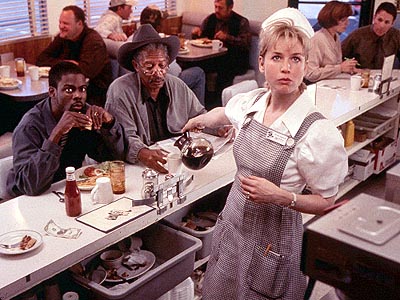 “Be honest and unmerciful,” says the revered rock critic Lester Bangs (Philip Seymour Hoffman) to the budding 15-year-old writer William Miller (Patrick Fugit) near the beginning of Almost Famous. That’s sound advice; it’s too bad more movie critics didn’t follow it when approaching this film. Perhaps it’s no mystery: Almost Famous, an amiably autobiographical film by Cameron Crowe (Say Anything…, Singles, Jerry Maguire), is nothing if not a valentine to critics — flattery of their innocence and integrity in the face of self-promoting rock bands, actors, or movie directors. If Lester Bangs had covered movies instead of music and had lived to see this one, he might’ve known what to make of it.
“Be honest and unmerciful,” says the revered rock critic Lester Bangs (Philip Seymour Hoffman) to the budding 15-year-old writer William Miller (Patrick Fugit) near the beginning of Almost Famous. That’s sound advice; it’s too bad more movie critics didn’t follow it when approaching this film. Perhaps it’s no mystery: Almost Famous, an amiably autobiographical film by Cameron Crowe (Say Anything…, Singles, Jerry Maguire), is nothing if not a valentine to critics — flattery of their innocence and integrity in the face of self-promoting rock bands, actors, or movie directors. If Lester Bangs had covered movies instead of music and had lived to see this one, he might’ve known what to make of it.
It needs to be said that Almost Famous is by no means a bad film — just a middling, loudly overpraised one (it has been heralded as Cameron Crowe’s epic or masterpiece, or something). The movie, as you may have heard, is based on Crowe’s own experiences as a teen rock journalist in the early ’70s, writing for Rolling Stone and meeting the rock gods of the day. Crowe’s onscreen surrogate is William, who squirms away from his well-meaning but overprotective mom (Frances McDormand, never once allowing her role to devolve into a stereotype) and spends some time on the road with an emerging, nothing-special band called Stillwater.
The wide-eyed William (whose portrayer, Patrick Fugit, must have been cast for his whitebread inoffensiveness to most demographics) is a more or less passive observer as the band members taste a few drops of fame — they’re opening for Black Sabbath — but are always on the verge of splitting up. The tipping point comes when the band’s t-shirt design favors Stillwater’s guitarist (Billy Crudup) over its lead singer (Jason Lee). Crowe may have actually witnessed such inane backstage hissy fits in his day, but unfortunately for him, the mock-rockumentary This Is Spinal Tap scooped him on the absurdity of rock egos by about fifteen years.
Almost Famous isn’t only about that, though — it’s also about maintaining one’s purity in the face of temptation: sex, drugs, fame, adulation. William hangs out a lot with a Stillwater hanger-on, a girl calling herself Penny Lane (Kate Hudson), who leads a pack of groupies who delude themselves that they aren’t groupies. I got a little restless as the familiar plot mechanics kicked into gear, setting up Penny as William’s first great love, who is drawn to the bad-boy excitement of rock stars but longs for a sweet, tender boy like William. And, by extension, like Crowe. And, by further extension, like the critics he’s flattering. Yes, movie critics, that sexy blonde may lust after bad boys, but deep down she’s really waiting for you.
As an admirer of Crowe’s earlier films, I was more than eager to see this one, but Almost Famous lacks dramatic focus. Crowe’s gentleness as a writer, so warming and refreshing in his romantic comedies, doesn’t help him much in this chaotic, post-Altamont rock milieu. In part, the movie is a love letter to Crowe’s remarkable adolescence, and I can accept that. But he softens just about everything, as if he didn’t want to hurt the feelings of anyone he knew back then. Autobiography shackles him; he has more freedom with characters he creates out of whole cloth. Penny Lane, for instance, is seen entirely through a gauze of affectionate memory, and Kate Hudson’s glimmer of adorableness dims after about half an hour; Hudson may be quirky enough to do something more interesting than this, but the evidence isn’t here.
On the road, William keeps calling his mentor, Lester Bangs, who advises him to ward off the fake friendship musicians use to suck in journalists. (Philip Seymour Hoffman, in his few minutes as Bangs, gives the movie some badly needed jolts of complexity and tension.) Almost Famous is a form of fake friendship, too; it wants us to believe we’ve been there with Crowe and shared a moment, but it offers little more insight than a typical Ron Howard film. Here’s a movie about a nice young man who meets a bunch of mostly nice people (even the jerks are basically harmless) and has nice adventures. The entire enterprise is too nice, too looking-back-fondly, too willing to let its characters and its audience off the hook. Almost Famous doesn’t pretend to be journalism, but it could’ve used a little more Lester Bangs in its soul.




